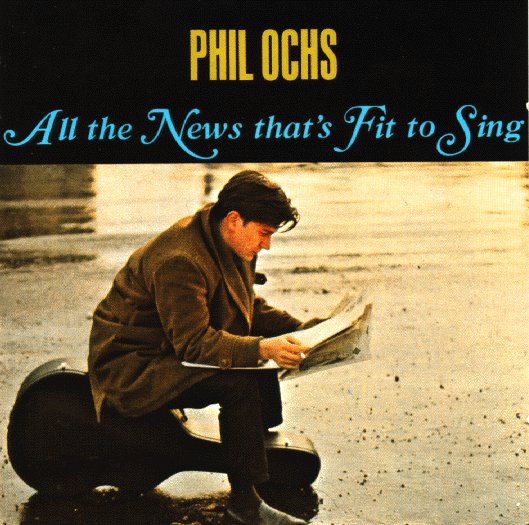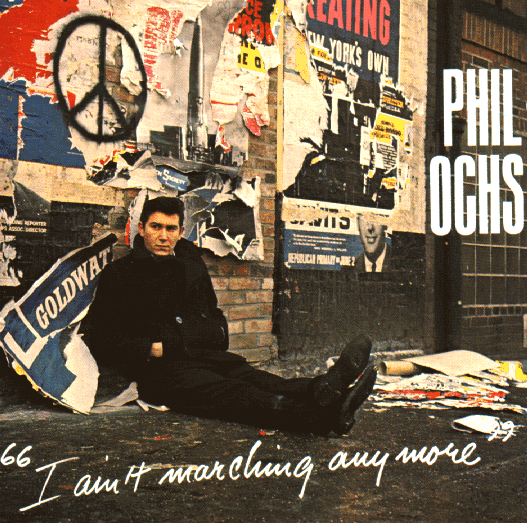.

Phil Ochs, Vancouver Gardens Arena, 13 March 1969: photo by Mark Millman
There But For Fortune, the Phil Ochs documentary directed by Ken Bowser, opens in New York
in January.
The film takes us back to the folk/protest epoch of the 1960s, and follows the career of Ochs
while chronicling the major social and political events of the period (civil rights, Viet Nam & c.).
Few of which the busy troubadour Ochs, spiritual offspring of Woody Guthrie and Pete Seeger,
did not work into a song.
It's remarked by a friend, in the film, that all Phil had to do to get a song was open the New York
Times.
Ochs' earnest sardonic lyrics, his bitter wit and biting commentary, were distinctive.
He had the voice of a crooner implanted upon a soul that was born to always be cankering about
something or other.
After some years of success, Ochs went into a bad decline, career-wise and personally. He drank
heavily. Friends feared for him.
The movie is frank, candid, unflinching on the subject of Ochs' many troubles. It's also terribly sad.
Ochs' brother Michael fearlessly confronts the issue of his brother's demons. You get the feeling
he's worked through all this before.
At a certain point about two-thirds of the way through the documentary, you get that Uh-oh, I don't
like where this is going feeling.
A fellow "counterculture" folk singer, the poet Ed Sanders, was close with Phil.
Sanders' testimony in the film is perhaps the most affecting of the many close-up talking-heads
reports.
Ochs was only thirty-five when he went out to his sister's place in Far Rockaway and hung himself.
Sanders recounts the shock of the news.
"I went out to where he was staying, you know, where he had hung himself.
"This was a day or so after it happened. He had hung himself off, I guess, a hook on the wall. I went
out there just to look at it, to re-create it in my mind.
"It was so horrifying.
* * *
"He attracted really close friendships, and that's why people [around him] were so traumatized, and
full of angst, in his later years.
"He just couldn't stop drinking. I know it was guilt. He felt guilty, you know, about his daughter and
his marriage.
"When you make mistakes there are no time machines to rectify mistakes, so mistakes are lodged
like harpoons and fish-hooks in an intelligent person's soul.
"And I think Phil couldn't get beyond those personal harpoons that made him feel, in some ways,
worthless."
And I'm sure it wouldn't interest anybody/Outside of a small circle of friends.
-- Phil Ochs: Outside of a Small Circle of Friends, from Pleasures of the Harbor, 1967
-- Phil Ochs: Outside of a Small Circle of Friends, from Pleasures of the Harbor, 1967

Phil Ochs: All the News that's Fit to Sing (1964), front cover: image via Michael Ochs Archives

Phil Ochs: I Ain't Marching Any More (1965), front cover: image via Michael Ochs Archives

Phil Ochs, Vancouver Gardens Arena, 13 March 1969: photo by Mark Millman
Thanks for this Tom. There were many at the time who dug what Phil was doing with his songs over what Dylan was after the latter seemed to have given up on "protest" and any kind of "reality" the rest of us seemed to be dealing with. I don't know about the "crooner" label though, he didn't have the tone or range for that, his voice was more piercing and insistent in a way that demanded you pay attention. At least the way I heard it at the time. I can hear it right now in my mind without having listened to him in quite a while. Back then I was totally impressed with his commitment and with his ability to turn a moment in contemporary history into an unforgettable song. But no young person I run into has any idea who he is.
ReplyDeleteWell, Mike, that voice was sweet and syrup-y smooth compared to Bobby's raspy sandpaper.
ReplyDeleteTed B. and I used to have endless pseudo-scholastic middle-of-the night stalemate debates over the respective merits of Phil and Jimi Hendrix.
These seemed like major issues to us at the time.
Of course you do remember the time.
The passages in the film with Ed S. talking are moving, breaking through the predictable rehearsed-memory shtick into real emotion.
Through Ed you can feel the loss that was felt.
(And while we're riding the time machine...)
ReplyDeleteThanks very much, indeed. What a good way to begin the morning, considering Phil Ochs and looking at those beautiful photos. I look forward to seeing the film. For me, Phil made an extraordinary first impression, and one that lasted and deepened. No one else at the time (or ever, possibly) would have essayed wearing the Elvis suit on the Greatest Hits album cover and "50 Phil Ochs Fans Can't Be Wrong" is still a very funny joke in the retelling. When I heard about his suicide (in Far Rockaway, as you say, very close to where I grew up), I was shocked but I was less familiar with suicide then and it didn't hit me quite as hard as suicides always do now. Caroline and I both dealt with Michael Ochs fairly regularly in record company publicity work (the Michael Ochs Archives, as it was called then also, was an invaluable resource) and he was lovely. People who knew him better than we told us how devastated he was by his brother's death, which is just the way things like this are. You never get past them. The photo and memorabilia collection grew, as I recall, out of their joint hobby of collecting and organizing precious relics of history that hadn't yet been recognized as such. This reminds me a bit of your comment about opening the newspaper as an immediate and relevant source of songwriting material. It's all there if you know how to see and render it. This is a link to a very good Gene Clark (w/Carla Olson) performance of Changes, which you might not be familiar with. It appeared on a Phil Ochs tribute album and also as a bonus track on the re-release of Gene and Carla's excellent So Rebellious A Lover record.
ReplyDeletehttp://www.youtube.com/watch?v=jVaVUeT0yvc
Curtis, I really like hearing Phil re-channeled through Gene Clark's Byrds-y sound.
ReplyDeleteHere's the trailer.
ReplyDeleteI'm glad you enjoyed it. When I first heard it, it immediately became a great favorite. If not "major" issues, discussing the respective merits of Phil Ochs and Jimi Hendrix (two artists I've never heard mentioned in the same conversation; I wonder why not? Jimi and Dylan come up all the time, obviously, and it's short, imaginative skip over to Phil) seems like a perfectly valid thing to do.
ReplyDeleteI think the point of contention probably came down to Sincerity vs. Sensation.
ReplyDeleteI think I can imagine the conversation and I assume that Phil assumed the role of Sincerity vs. Jimi as Sensation. One of the most amusing, telling pieces of interview footage I've ever seen is included in a movie called A Film About Hendrix. A journalist asks Jimi in a clearly challenging (but nonetheless relevant) way whether he uses "gimmicks". Jimi sort of tortures and abuses the question for a while in his response before concluding in a very knowing, good humored way that of course he uses gimmicks. It was one of the most sincere, candid and complete responses I've ever seen from an artist, who when he was in control and in focus, really wore his heart and feelings on his sleeve. I assume most professional performers would identify with Hendrix's discomfort at the question and the honesty of his reply. As the Harry Houdini character I saw in a movie on tv this weekend said when asked by a London reporter to explain how he slipped his manacles, "a good illusionist never reveals his secrets".
ReplyDeleteCurtis,
ReplyDeleteI saw Hendrix twice in the first week of his first performances as a headline act in small clubs in London with the band put together for him by Chas Chandler.
The things he was doing went beyond anything anyone had yet seen or heard, and if they were gimmicks, or concepts, or tricks, or accidents of nature, they were certainly, if nothing else, different.
Of a different order of experience.
I was not the only person who had this reaction.
The first time I saw him, at the Marquee Club, the tiny house was jammed to the low ceiling with people who had got the word that something unusual was to be expected.
John Mayall was lying on the stage at Hendrix's feet, with a small hand-held movie camera, filming him as he played.
Peter Townshend, wearing a long orange scarf, was hanging by one arm from the pipe of an air vent above the stage, his eyes very large.
So, there it was. Something else, from another dimension.
Later on the entertainment biz swallowed him up as it swallows everything else (and this was already beginning to happen just a bit later, when he brought the act back to New York); but for that moment, the show was transcendent.
That's the point I was not able to get across to my friend Ted, in the ensuing time in NYC, in the charming late night pseudo-scholastic discussions.
I liked Phil Ochs too, but Phil was... mortal.